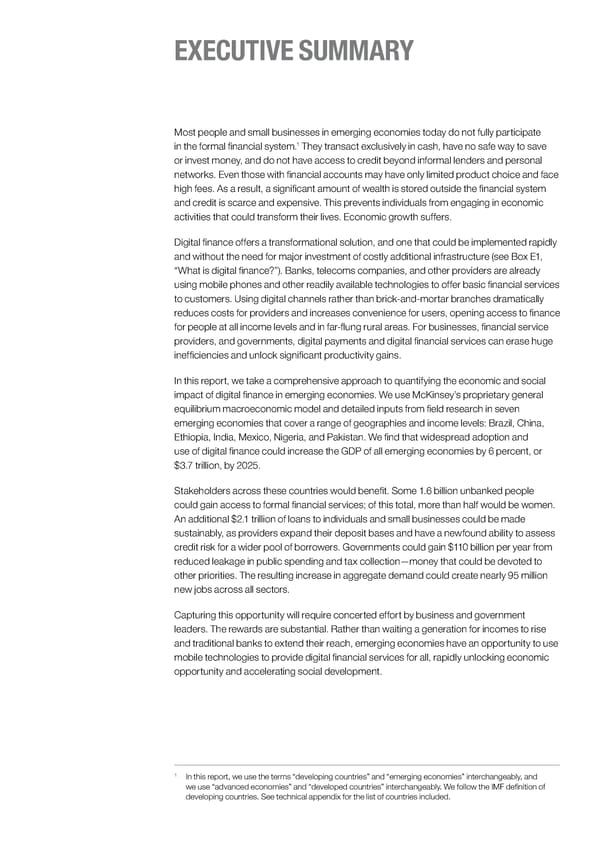EXECUTIVE SUMMARY
EXECUTIVE SUMMARY Most people and small businesses in emerging economies today do not fully participate 1 in the formal financial system. They transact exclusively in cash, have no safe way to save or invest money, and do not have access to credit beyond informal lenders and personal networks. Even those with financial accounts may have only limited product choice and face high fees. As a result, a significant amount of wealth is stored outside the financial system and credit is scarce and expensive. This prevents individuals from engaging in economic activities that could transform their lives. Economic growth suffers. Digital finance offers a transformational solution, and one that could be implemented rapidly and without the need for major investment of costly additional infrastructure (see Box E1, “What is digital finance?”). Banks, telecoms companies, and other providers are already using mobile phones and other readily available technologies to offer basic financial services to customers. Using digital channels rather than brick-and-mortar branches dramatically reduces costs for providers and increases convenience for users, opening access to finance for people at all income levels and in far-flung rural areas. For businesses, financial service providers, and governments, digital payments and digital financial services can erase huge inefficiencies and unlock significant productivity gains. In this report, we take a comprehensive approach to quantifying the economic and social impact of digital finance in emerging economies. We use McKinsey’s proprietary general equilibrium macroeconomic model and detailed inputs from field research in seven emerging economies that cover a range of geographies and income levels: Brazil, China, Ethiopia, India, Mexico, Nigeria, and Pakistan. We find that widespread adoption and use of digital finance could increase the GDP of all emerging economies by 6 percent, or $3.7 trillion, by 2025. Stakeholders across these countries would benefit. Some 1.6 billion unbanked people could gain access to formal financial services; of this total, more than half would be women. An additional $2.1 trillion of loans to individuals and small businesses could be made sustainably, as providers expand their deposit bases and have a newfound ability to assess credit risk for a wider pool of borrowers. Governments could gain $110 billion per year from reduced leakage in public spending and tax collection—money that could be devoted to other priorities. The resulting increase in aggregate demand could create nearly 95 million new jobs across all sectors. Capturing this opportunity will require concerted effort by business and government leaders. The rewards are substantial. Rather than waiting a generation for incomes to rise and traditional banks to extend their reach, emerging economies have an opportunity to use mobile technologies to provide digital financial services for all, rapidly unlocking economic opportunity and accelerating social development. 1 In this report, we use the terms “developing countries” and “emerging economies” interchangeably, and we use “advanced economies” and “developed countries” interchangeably. We follow the IMF definition of developing countries. See technical appendix for the list of countries included.
 EXECUTIVE SUMMARY Page 2
EXECUTIVE SUMMARY Page 2